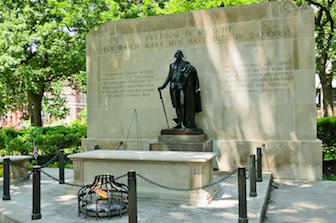
Philadelphia’s Five Original Squares
No city pays more tribute to its founding father than Philadelphia. William Penn’s 17th century vision of crafting a “greene Countrie Towne” continues to shape the city well into the 21st.
Today, Philly’s five public squares are epicenters of activity that call residents out of their homes and into the park to play, socialize and chat with their fellow citizens. From the city’s finest restaurants to its most sought-after real estate, all that is Philadelphia radiates from her five original squares.
A Taste of History
Given the plot of land where Philadelphia now sits by King Charles II to settle a family debt, Penn set out to create a tolerant political utopia for those persecuted for their religion in England.
His original city map was published as an advertisement, meant to inspire settlers from England to sail the ocean and populate a new sort of town. While most fledgling New England settlements were unplanned hodgepodges of misshapen plots and winding horse tracks, Penn devised a new system, one that would eventually permeate urban planning across America and the globe.
So simple yet innovative for its time, Penn’s grid system of streets and blocks featured a public square in each of its four quadrants and a fifth square in the center of town, aptly named “Centre Square.”
In 1825, Southwest, Southeast, Northwest and Northeast squares were given their present-day names of Rittenhouse, Washington, Logan and Franklin. In the center? How could it be anything but Penn.
Rittenhouse: The Most Vibrant Outdoor Space in Town
Encircled by luxury high-rises, cultural attractions and some of the best outdoor dining on the east coast, Rittenhouse Square and its surroundings offer a pleasant day of high-end shopping and marvelous stately Victorian homes.
Fashionable, chic and home to several of the city’s most famed sculptures, Rittenhouse attracts an extremely diverse crowd, from successful professionals to working class families and street performers. It’s the place to soak up the sun, admire finely manicured gardens and people watch by the fountain.
Washington: Home of Independence Hall
Part of Independence National Historic Park, Washington Square is as picturesque as Rittenhouse sans the hustle and bustle.
Peaceful, leafy and serene, historic Washington Square provides an escape—a place to relax and unwind. It’s somewhere to walk through the archives of history and to pay respect to the Tomb of the Unknown Revolutionary War Soldier.
Logan: Architectural Mastery
Logan Circle, once called Northwest Square, is the gateway to Benjamin Franklin Parkway, a wide scenic boulevard cut through the city in the early 1900s.
Home to Philadelphia’s most admired water feature, Swann Fountain, Logan Circle offers stunning views of the Philadelphia Museum of Art, the Franklin Institute, the Barnes Foundation and the Academy of Natural Sciences.
Franklin: A Family Affair
Nearly demolished with the construction of the Benjamin Franklin Bridge, Franklin Square is trying hard to make the most of its second chance with a vintage carousel and family-themed entertainment.
Though less glamorous and far less prestigious than its counterparts, Franklin is making every effort to work its way up the food chain.
Penn: A City Hall Like No Other
Of the five original squares, there’s only one that’s no longer a public space. Philadelphia’s magnificent City Hall once towered over Penn Square in ostentatious glory. Modeled after a medieval European castle, City Hall remains one of the largest municipal buildings in the world and the tallest freestanding masonry structure on the planet.

